A Machine-Learning Approach to Measure the Anterior Cruciate Ligament Injury Risk in Female Basketball Players
Abstract
1. Introduction
2. Materials and Methods
2.1. Participants
2.2. Experimental Setup and Protocol
2.3. Data Analysis and Feature Extraction
2.3.1. Clinical Assessment Phase: LESS Score
2.3.2. Sensor-Based Assessment Phase: mCMJ and SLS
Leg Stability
- The total length of the path in the plane, named PL;
- The total length of the path in antero-posterior direction, named PLAP;
- The total length of the path in medio-lateral direction, named PLML;
- The area of the bivariate confidence ellipse that includes at least 99% of the projection points, named EA.
Load Absorption Capability
2.4. Machine-Learning Algorithms
2.5. Performance Evaluation
3. Results
4. Discussions
Is It Possible to Use a Machine-Learning Approach to Measure the ACL Risk?
Implications
5. Conclusions
Author Contributions
Funding
Institutional Review Board Statement
Informed Consent Statement
Data Availability Statement
Conflicts of Interest
References
- Fédération Internationale de Basketball (FIBA) Quick Facts. 2019. Available online: www.fiba.com (accessed on 28 February 2021).
- Taylor, J.B.; Ford, K.R.; Nguyen, A.D.; Terry, L.N.; Hegedus, E.J. Prevention of Lower Extremity Injuries in Basketball: A Systematic Review and Meta-Analysis. Sports Health 2015, 7, 392–398. [Google Scholar] [CrossRef] [PubMed]
- Ford, K.R.; Myer, G.D.; Hewett, T.E. Valgus knee motion during landing in high school female and male basketball players. Med. Sci. Sports Exerc. 2003, 35, 1745–1750. [Google Scholar] [CrossRef] [PubMed]
- Myer, G.D.; Ford, K.R.; Brent, J.L.; Hewett, T.E. Differential neuromuscular training effects on ACL injury risk factors in “high-risk” versus “low-risk” athletes. BMC Musculoskelet. Disord. 2007, 8, 1–7. [Google Scholar] [CrossRef] [PubMed]
- Prodromos, C.C.; Han, Y.; Rogowski, J.; Joyce, B.; Shi, K. A Meta-analysis of the Incidence of Anterior Cruciate Ligament Tears as a Function of Gender, Sport, and a Knee Injury-Reduction Regimen. Arthrosc. J. Arthrosc. Relat. Surg. 2007, 23, 1320–1325. [Google Scholar] [CrossRef]
- Zelisko, J.A.; Noble, H.B.; Porter, M. A comparison of men’s and women’s professional basketball injuries. Am. J. Sports Med. 1982, 10, 297–299. [Google Scholar] [CrossRef] [PubMed]
- Swenson, D.M.; Collins, C.L.; Best, T.M.; Flanigan, D.C.; Fields, S.K.; Comstock, R.D. Epidemiology of knee injuries among U.S. high school athletes, 2005/2006–2010/2011. Med. Sci. Sports Exerc. 2013, 45, 462–469. [Google Scholar] [CrossRef] [PubMed]
- Hewett, T.E.; Myer, G.D.; Ford, K.R.; Paterno, M.V.; Quatman, C.E. Mechanisms, prediction, and prevention of ACL injuries: Cut risk with three sharpened and validated tools. J. Orthop. Res. 2016, 34, 1843–1855. [Google Scholar] [CrossRef]
- Dai, B.; Herman, D.; Liu, H.; Garrett, W.E.; Yu, B. Prevention of ACL injury, Part I: Injury characteristics, risk factors, and loading mechanism. Res. Sport. Med. 2012, 20, 180–197. [Google Scholar] [CrossRef]
- Boden, B.P.; Sheehan, F.T.; Torg, J.S.; Hewett, T.E. Non-contact ACL Injuries: Mechanisms and Risk Factors. Am. Acad. Orthop. Surg. 2010, 18, 520–527. [Google Scholar] [CrossRef]
- Saadat, S.; Stephenson, M.L.; Gillette, J.C. Altering Entry Angles in a Jump Landing Task Modifies Biomechanical Risk Factors of ACL Injury. In Proceedings of the 37th International Conference on Biomechanics in Sports 2019, Oxford, OH, USA, 21–25 July 2019; pp. 53–56. [Google Scholar]
- Ferrer, A.; Twycross-Lewis, R.; Maffulli, N. Anterior cruciate ligament deficiency: Rotational instability in the transverse plane. A preliminary laboratory in vivo study. Muscles Ligaments Tendons J. 2019, 9, 55–61. [Google Scholar] [CrossRef]
- Chiu, L.Z.F.; Bryanton, M.A.; Moolyk, A.N.; Newstead, L.; Kennedy, M.D. Improvements in Joint Kinetics in Return to Competition from ACL Injury and Reconstruction: A Caste Study. 2011. Available online: https://www.academia.edu/30285485/Improvements_in_Joint_Kinetics_in_Return_to_Competition_from_Acl_Injury_and_Reconstruction_A_Case_Study (accessed on 15 January 2021).
- Neri, T.; Testa, R.; Laurendon, L.; Dehon, M.; Putnis, S.; Grasso, S.; Parker, D.A.; Farizon, F.; Philippot, R. Determining the change in length of the anterolateral ligament during knee motion: A three-dimensional optoelectronic analysis. Clin. Biomech. 2019, 62, 86–92. [Google Scholar] [CrossRef]
- Carlson, V.R.; Sheehan, F.T.; Boden, B.P. Video analysis of anterior cruciate ligament (ACL) injuries: A systematic review. JBJS Rev. 2016, 4, e5. [Google Scholar] [CrossRef] [PubMed]
- Della Villa, F.; Buckthorpe, M.; Grassi, A.; Nabiuzzi, A.; Tosarelli, F.; Zaffagnini, S.; Della Villa, S. Systematic video analysis of ACL injuries in professional male football (soccer): Injury mechanisms, situational patterns and biomechanics study on 134 consecutive cases. Br. J. Sports Med. 2020, 54, 1423–1432. [Google Scholar] [CrossRef] [PubMed]
- Mikkelsen, M.; Peterson, A.; Rinkenberger, T.; Peterson, A. Using the Landing Error Scoring System (LESS) to Predict the Risk of Lower Extremity Injuries in Athletes. Phys. Ther. Sch. Proj. 2019, 677. [Google Scholar]
- Padua, D.A.; Marshall, S.W.; Boling, M.C.; Thigpen, C.A.; Garrett, W.E.; Beutler, A.I. The Landing Error Scoring System (LESS) is a valid and reliable clinical assessment tool of jump-landing biomechanics: The jump-ACL Study. Am. J. Sports Med. 2009, 37, 1996–2002. [Google Scholar] [CrossRef]
- Everard, E.; Lyons, M.; Harrison, A.J. Examining the reliability of the landing error scoring system with raters using the standardized instructions and scoring sheet. J. Sport Rehabil. 2020, 29, 519–525. [Google Scholar] [CrossRef]
- Schwartz, O.; Talmy, T.; Olsen, C.H.; Dudkiewicz, I. The Landing Error Scoring System Real-Time test as a predictive tool for knee injuries: A historical cohort study. Clin. Biomech. 2020, 73, 115–121. [Google Scholar] [CrossRef]
- Smith, H.; Johnson, R.; Shultz, S.; Tourville, T.; Holterman, L.; Slauterbeck, J.; Vacek, P.; Beynnon, B. A Prospective Evaluation of the Landing Error Scoring System (LESS) as a Screening Tool for Anterior Cruciate Ligament Injury Risk. Am. J. Sport. Med. 2012, 176, 521–526. [Google Scholar] [CrossRef]
- Molinaro, L.; Santospagnuolo, A.; Vulpiani, M.; Taborri, J.; Vetrano, M.; Rossi, S. Can the measurements of leg stability during jump landing predict and monitor anterior cruciate ligament injury? A case report of basketball player. In Proceedings of the IEEE International Conference on Medical Measurement and Applications (MeMeA 2020), Bari, Italy, 31 May–2 June 2020; pp. 1–6. [Google Scholar]
- Seshadri, D.R.; Li, R.T.; Voos, J.E.; Rowbottom, J.R.; Alfes, C.M.; Zorman, C.A.; Drummond, C.K. Wearable sensors for monitoring the internal and external workload of the athlete. Digit. Med. 2019, 2, 1–18. [Google Scholar] [CrossRef]
- Mazlan, S.S.; Ayob, M.Z.; Bakti, Z.A.K. Anterior cruciate ligament (ACL) injury classification system using support vector machine (SVM). In Proceedings of the International Conference on Engineering Technology and Technopreneurship (ICE2T), Kuala Lumpur, Malaysia, 18–20 September 2017; pp. 1–5. [Google Scholar]
- Chang, P.D.; Wong, T.T.; Rasiej, M.J. Deep Learning for Detection of Complete Anterior Cruciate Ligament Tear. J. Digit. Imaging 2019, 32, 980–986. [Google Scholar] [CrossRef]
- Claudino, J.G.; de Oliveira Capanema, D.; de Souza, T.V.; Serrão, J.C.; Machado Pereira, A.C.; Nassis, G.P. Current Approaches to the Use of Artificial Intelligence for Injury Risk Assessment and Performance Prediction in Team Sports: A Systematic Review. Sport. Med. Open 2019, 5, 28. [Google Scholar] [CrossRef]
- Lao, Y.; Jia, B.; Yan, P.; Pan, M.; Hui, X.; Li, J.; Luo, W.; Li, X.; Han, J.; Yan, P.; et al. Diagnostic accuracy of machine-learning-assisted detection for anterior cruciate ligament injury based on magnetic resonance imaging: Protocol for a systematic review and meta-analysis. Med. Baltim. 2019, 98, 1–5. [Google Scholar] [CrossRef]
- Jauhiainen, S.; Kauppi, J.P.; Leppänen, M.; Pasanen, K.; Parkkari, J.; Vasankari, T.; Kannus, P.; Äyrämö, S. New Machine Learning Approach for Detection of Injury Risk Factors in Young Team Sport Athletes. Int. J. Sports Med. 2020. [Google Scholar] [CrossRef]
- Oliver, J.L.; Ayala, F.; De Ste Croix, M.B.A.; Lloyd, R.S.; Myer, G.D.; Read, P.J. Using machine learning to improve our understanding of injury risk and prediction in elite male youth football players. J. Sci. Med. Sport 2020, 23, 1044–1048. [Google Scholar] [CrossRef] [PubMed]
- Tedesco, S.; Crowe, C.; Ryan, A.; Sica, M.; Scheurer, S.; Clifford, A.M.; Brown, K.N.; O’Flynn, B. Motion sensors-based machine learning approach for the identification of anterior cruciate ligament gait patterns in on-the-field activities in rugby players. Sensors 2020, 20, 3029. [Google Scholar] [CrossRef]
- Khan, M.A.; Kim, Y. Cardiac arrhythmia disease classification using LSTM deep learning approach. Comput. Mater. Contin. 2021, 67, 427–443. [Google Scholar] [CrossRef]
- Ruiz-Pérez, I.; López-Valenciano, A.; Hernández-Sánchez, S.; Puerta-Callejón, J.M.; De Ste Croix, M.; Sainz de Baranda, P.; Ayala, F. A Field-Based Approach to Determine Soft Tissue Injury Risk in Elite Futsal Using Novel Machine Learning Techniques. Front. Psychol. 2021, 12, 195. [Google Scholar] [CrossRef]
- Yassin, N.I.R.; Omran, S.; El Houby, E.M.F.; Allam, H. Machine learning techniques for breast cancer computer aided diagnosis using different image modalities: A systematic review. Comput. Methods Programs Biomed. 2018, 156, 25–45. [Google Scholar] [CrossRef]
- Parwaiz, H.; Teo, A.Q.A.; Servant, C. Anterior cruciate ligament injury: A persistently difficult diagnosis. Knee 2016, 23, 116–120. [Google Scholar] [CrossRef]
- Molinaro, L.; Taborri, J.; Montecchiani, M.; Rossi, S. Assessing the effects of kata and kumite techniques on physical performance in elite karatekas. Sensors 2020, 20, 3186. [Google Scholar] [CrossRef]
- Van der Straaten, R.; Bruijnes, A.K.B.D.; Vanwanseele, B.; Jonkers, I.; De Baets, L.; Timmermans, A. Reliability and agreement of 3D trunk and lower extremity movement analysis by means of inertial sensor technology for unipodal and bipodal tasks. Sensors 2019, 19, 141. [Google Scholar] [CrossRef] [PubMed]
- Taborri, J.; Palermo, E.; Del Prete, Z.; Rossi, S. On the reliability and repeatability of surface electromyography factorization by muscle synergies in daily life activities. Appl. Bionics Biomech. 2018, 2018, 1–15. [Google Scholar] [CrossRef]
- Padua, D.A.; DiStefano, L.J.; Beutler, A.I.; De La Motte, S.J.; DiStefano, M.J.; Marshall, S.W. The landing error scoring system as a screening tool for an anterior cruciate ligament injury-prevention program in elite-youth soccer athletes. J. Athl. Train. 2015, 50, 589–595. [Google Scholar] [CrossRef]
- Mahony, R.; Hamel, T.; Pflimlin, J.-M. Complementary filter design on the special orthogonal group SO(3). In Proceedings of the 2005 44th IEEE Conference on Decision and Control & European Control Conference, Seville, Spain, 12–15 December 2005. [Google Scholar]
- Prieto, T.E.; Myklebust, J.B.; Hoffmann, R.G.; Lovett, E.G.; Myklebust, B.M. Measures of postural steadiness: Differences between healthy young and elderly adults. IEEE Trans. Biomed. Eng. 1996, 43, 956–966. [Google Scholar] [CrossRef] [PubMed]
- Koga, H.; Nakamae, A.; Shima, Y.; Iwasa, J.; Myklebust, G.; Engebretsen, L.; Bahr, R.; Krosshaug, T. Mechanisms for noncontact anterior cruciate ligament injuries: Knee joint kinematics in 10 injury situations from female team handball and basketball. Am. J. Sports Med. 2010, 38, 2218–2225. [Google Scholar] [CrossRef]
- Kim, S.H.; Kwon, O.Y.; Park, K.N.; Jeon, I.C.; Weon, J.H. Lower extremity strength and the range of motion in relation to squat depth. J. Hum. Kinet. 2015, 45, 59–69. [Google Scholar] [CrossRef] [PubMed]
- Endo, Y.; Miura, M.; Sakamoto, M. The relationship between the deep squat movement and the hip, knee and ankle range of motion and muscle strength. J. Phys. Ther. Sci. 2020, 32, 391–394. [Google Scholar] [CrossRef] [PubMed]
- Lee, H.H.; Lin, C.W.; Wu, H.W.; Wu, T.C.; Lin, C.F. Changes in biomechanics and muscle activation in injured ballet dancers during a jump-land task with turnout (Sissonne Fermée). J. Sports Sci. 2012, 30, 689–697. [Google Scholar] [CrossRef] [PubMed]
- Preece, S.J.; Paul, L.; Kenney, J.; Meijer, K.; Crompton, R.H.; Goulermas, J.Y.; Kenney, L.P.J.; Howard, D.; Crompton, R. Activity Identification Using Body-Mounted Sensors-A Review of Classification Techniques. Physiol. Meas. 2009, 30, 1–33. [Google Scholar] [CrossRef] [PubMed]
- Taborri, J.; Palermo, E.; Rossi, S. Automatic detection of faults in race walking: A comparative analysis of machine-learning algorithms fed with inertial sensor data. Sensors 2019, 19, 1461. [Google Scholar] [CrossRef] [PubMed]
- Fernandez Hilario, A.; Garcia Lopez, S.; Galar, M.; Prati, R.; Krawczyk, B.; Herrera, F. Learning from Imbalanced Data Sets; Fernandez Hilario, A., Ed.; Springer: Berlin, Germany, 2018; Volume 11. [Google Scholar]
- Batista, G.E.A.P.A.; Prati, R.C.; Monard, M.C. A study of the behavior of several methods for balancing machine learning training data. ACM SIGKDD Explor. Newsl. 2004, 6, 20–29. [Google Scholar] [CrossRef]
- Han, H.; Guo, X.; Yu, H. Variable Selection Using Mean Decrease Accuracy and Mean Decrease Gini Based on Random Forest. In Proceedings of the 7th IEEE International Conference on Software Engineering and Service Science (ICSESS), Beijing, China, 26–28 August 2016; pp. 219–224. [Google Scholar]
- Zhang, Z.; Yang, Z.; Ren, W.; Wen, G. Random forest-based real-time defect detection of Al alloy in robotic arc welding using optical spectrum. J. Manuf. Process. 2019, 42, 51–59. [Google Scholar] [CrossRef]
- Dancey, C.P.; Reidy, J. Statistics without Maths for Psychology; Pearson: London, UK, 2007. [Google Scholar]
- Swärd, P.; Kostogiannis, I.; Roos, H. Risk factors for a contralateral anterior cruciate ligament injury. Knee Surg. Sport. Traumatol. Arthrosc. 2010, 18, 1–15. [Google Scholar] [CrossRef] [PubMed]
- Yin, S.; Yin, J. Tuning kernel parameters for SVM based on expected square distance ratio. Inf. Sci. N. Y. 2016, 370–371, 92–102. [Google Scholar] [CrossRef]
- Tjärnberg, A.; Mahmood, O.; Jackson, C.; Saldi, G.-A.; Cho, K.; Christiaen, L.; Bonneau, R. Optimal tuning of weighted kNN- and diffusion-based methods for denoising single cell genomics data. PLoS Comput. Biol. 2020. [Google Scholar] [CrossRef]
- Soon Ong, C.; Smola, A.J.; Williamson, R.C. Learning the Kernel with Hyperkernels. J. Mach. Learn. Res. 2005, 6, 1043–1071. [Google Scholar]
- Chaka, K.; Le Thanh, N.; Flamary, R.; Belleudy, C. Performance Comparison of the KNN and SVM Classification Algorithms in the Emotion Detection System EMOTICA. Int. J. Sens. Netw. Data Commun. 2018, 7, 1–9. [Google Scholar] [CrossRef]
- Mannini, A.; Sabatini, A.M. Machine learning methods for classifying human physical activity from on-body accelerometers. Sensors 2010, 10, 1154–1175. [Google Scholar] [CrossRef] [PubMed]
- Shimokochi, Y.; Ambegaonkar, J.P.; Meyer, E.G.; Lee, S.Y.; Shultz, S.J. Changing sagittal plane body position during single-leg landings influences the risk of non-contact anterior cruciate ligament injury. Knee Surg. Sport. Traumatol. Arthrosc. 2013, 21, 888–897. [Google Scholar] [CrossRef] [PubMed]
- Romanchuk, N.J.; Del Bel, M.J.; Benoit, D.L. Sex-specific landing biomechanics and energy absorption during unanticipated single-leg drop-jumps in adolescents: Implications for knee injury mechanics. J. Biomech. 2020, 113, 110064. [Google Scholar] [CrossRef]
- Asaeda, M.; Nakamae, A.; Hirata, K.; Kono, Y.; Uenishi, H.; Adachi, N. Factors associated with dynamic knee valgus angle during single-leg forward landing in patients after anterior cruciate ligament reconstruction. Asia-Pac. J. Sport. Med. Arthrosc. Rehabil. Technol. 2020, 22, 56–61. [Google Scholar] [CrossRef] [PubMed]
- Steffen, K.; Nilstad, A.; Krosshaug, T.; Pasanen, K.; Bahr, R. No Association Between Static and Dynamic Postural Control and Acl Injury Risk Among Female Elite Handball and Football Players. Br. J. Sports Med. 2017, 51, 253–259. [Google Scholar] [CrossRef] [PubMed]
- Bailey, I.L.; Bullimore, M.A.; Raasch, T.W.; Taylor, H.R. Clinical grading and the effects of scaling. Investig. Ophthalmol. Vis. Sci. 1991, 32, 422–432. [Google Scholar]
- Dos Santos, T.; Thomas, C.; McBurnie, A.; Donelon, T.; Herrington, L.; Jones, P.A. The Cutting Movement Assessment Score (CMAS) Qualitative Screening Tool: Application to Mitigate Anterior Cruciate Ligament Injury Risk during Cutting. Biomechanics 2021, 1, 83–101. [Google Scholar] [CrossRef]
- Waldén, M.; Hägglund, M.; Magnusson, H.; Ekstrand, J. ACL injuries in men’s professional football: A 15-year prospective study on time trends and return-to-play rates reveals only 65% of players still play at the top level 3 years after ACL rupture. Br. J. Sports Med. 2016, 50, 744–750. [Google Scholar] [CrossRef] [PubMed]
- Xu, D.; Jiang, X.; Cen, X.; Baker, J.S.; Gu, Y. Single-Leg Landings Following a Volleyball Spike May Increase the Risk of Anterior Cruciate Ligament Injury More Than Landing on Both-Legs. Appl. Sci. 2020, 11, 130. [Google Scholar] [CrossRef]
- Ying, J.; Cen, X.; Yu, P. Effects of Eccentric Exercise on Skeletal Muscle Injury: From an Ultrastructure Aspect: A Review. Phys. Act. Health 2021, 5, 15–20. [Google Scholar] [CrossRef]
- Di Paolo, S.; Lopomo, N.F.; Della Villa, F.; Paolini, G.; Figari, G.; Bragonzoni, L.; Grassi, A.; Zaffagnini, S. Rehabilitation and Return to Sport Assessment after Anterior Cruciate Ligament Injury: Quantifying Joint Kinematics during Complex High-Speed Tasks through Wearable Sensors. Sensors 2021, 21, 2331. [Google Scholar] [CrossRef]
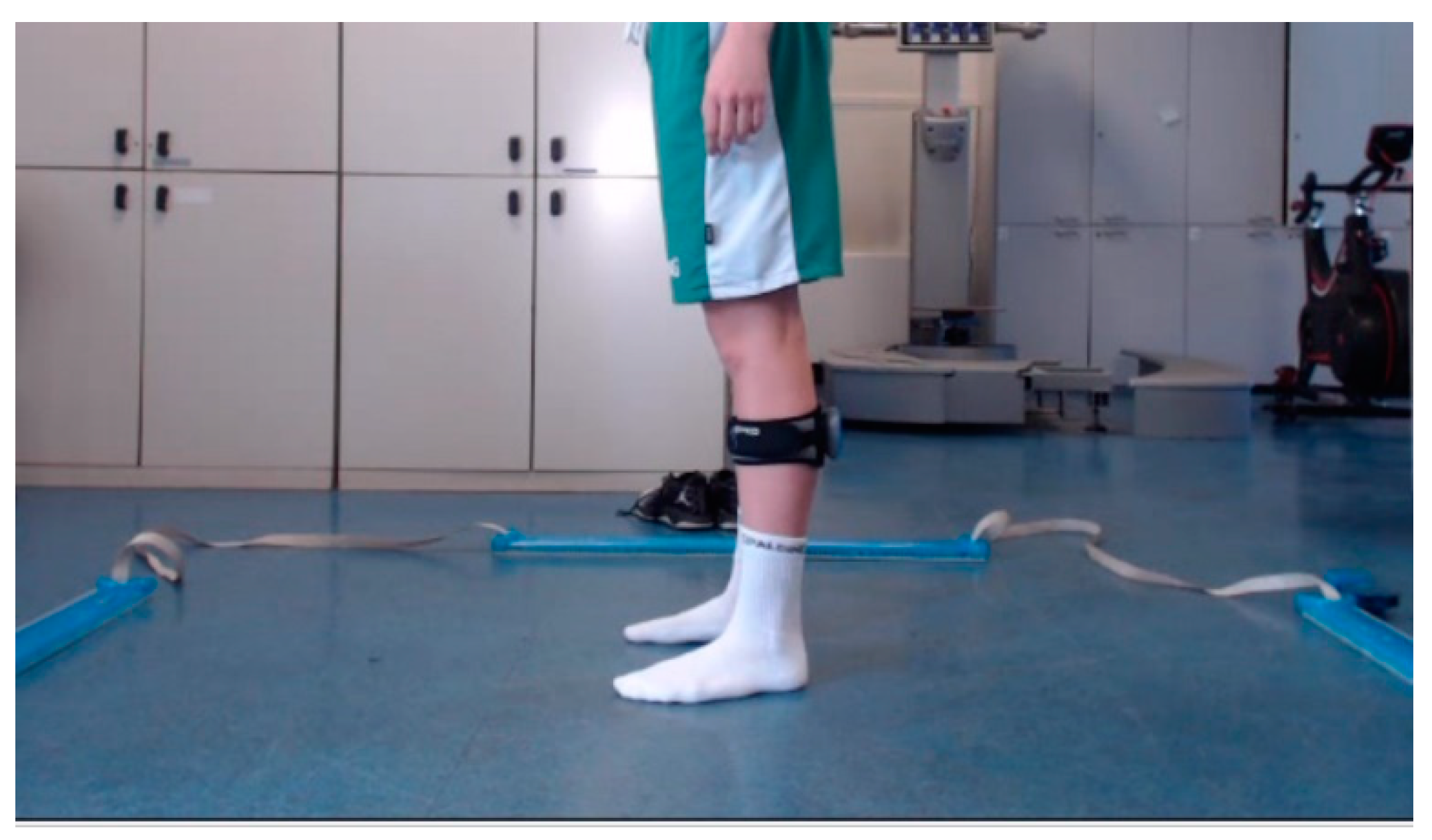
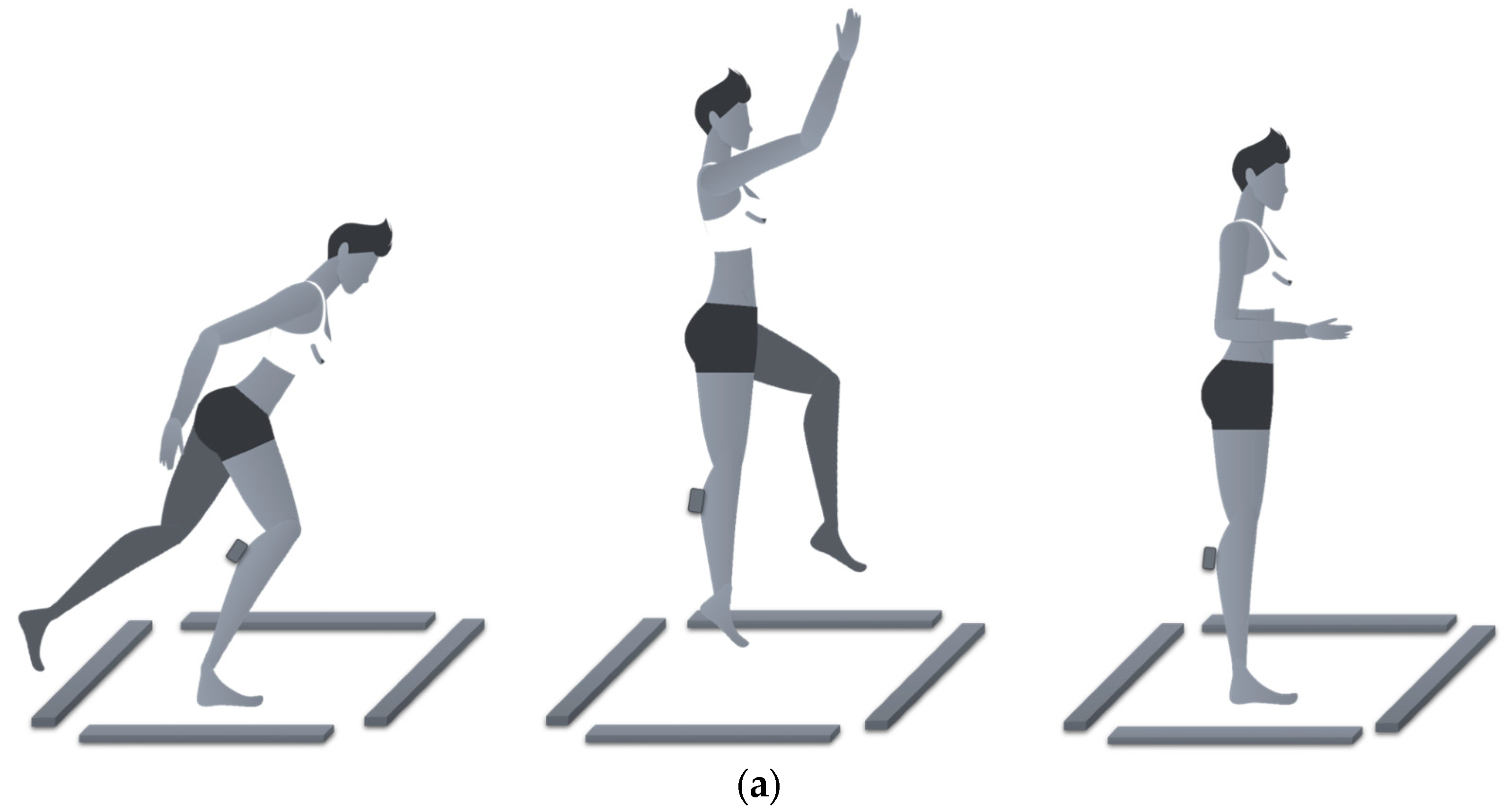
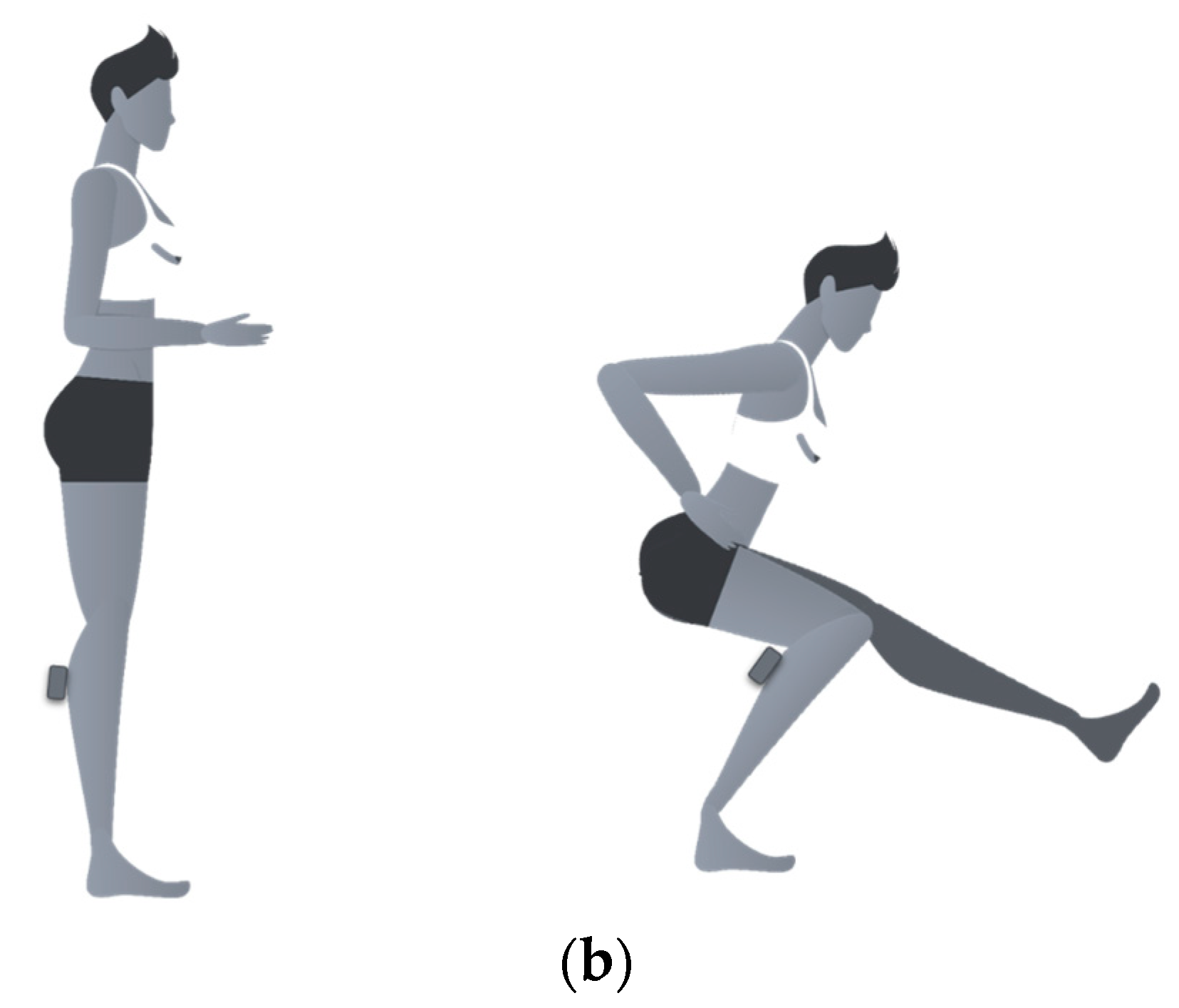
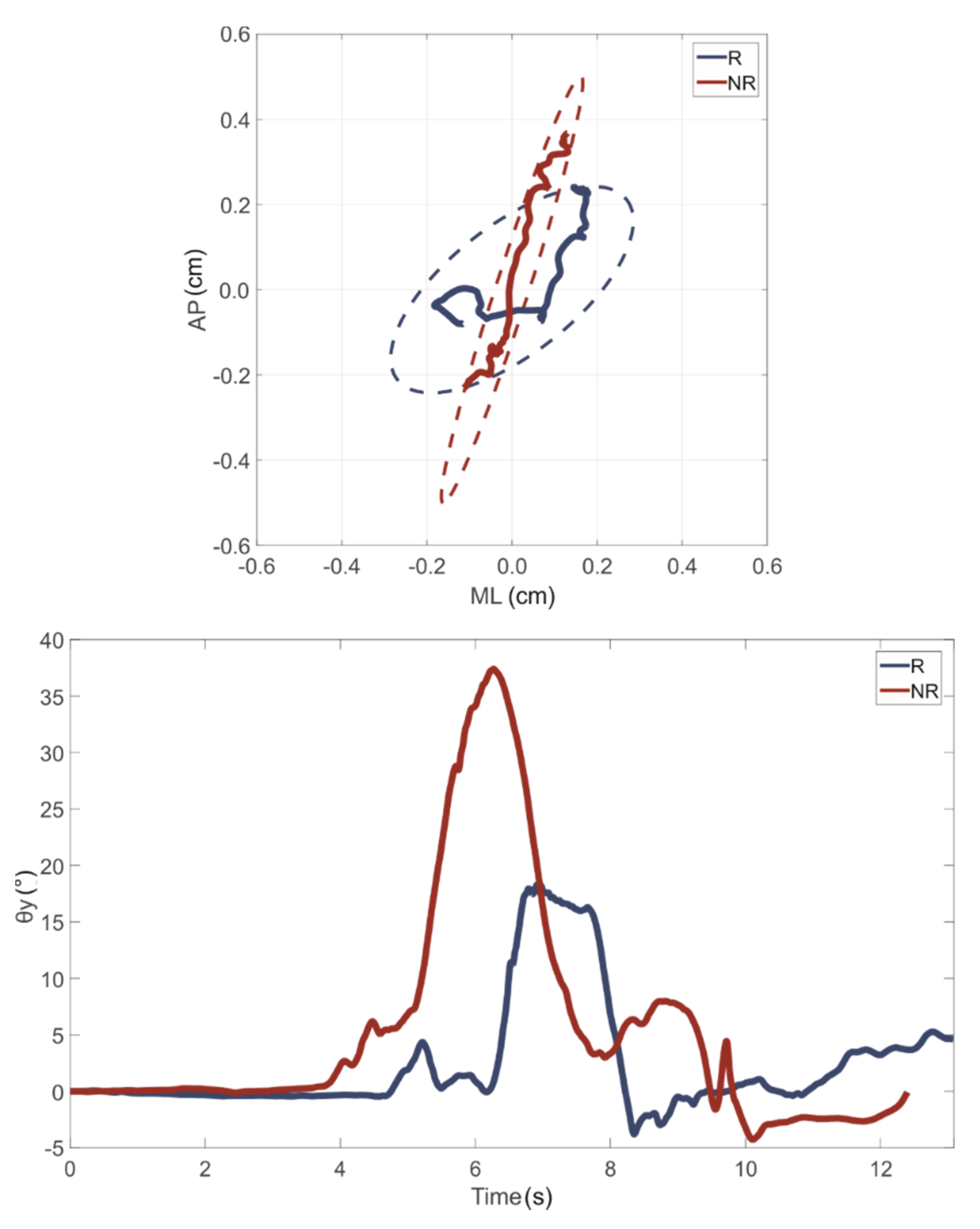
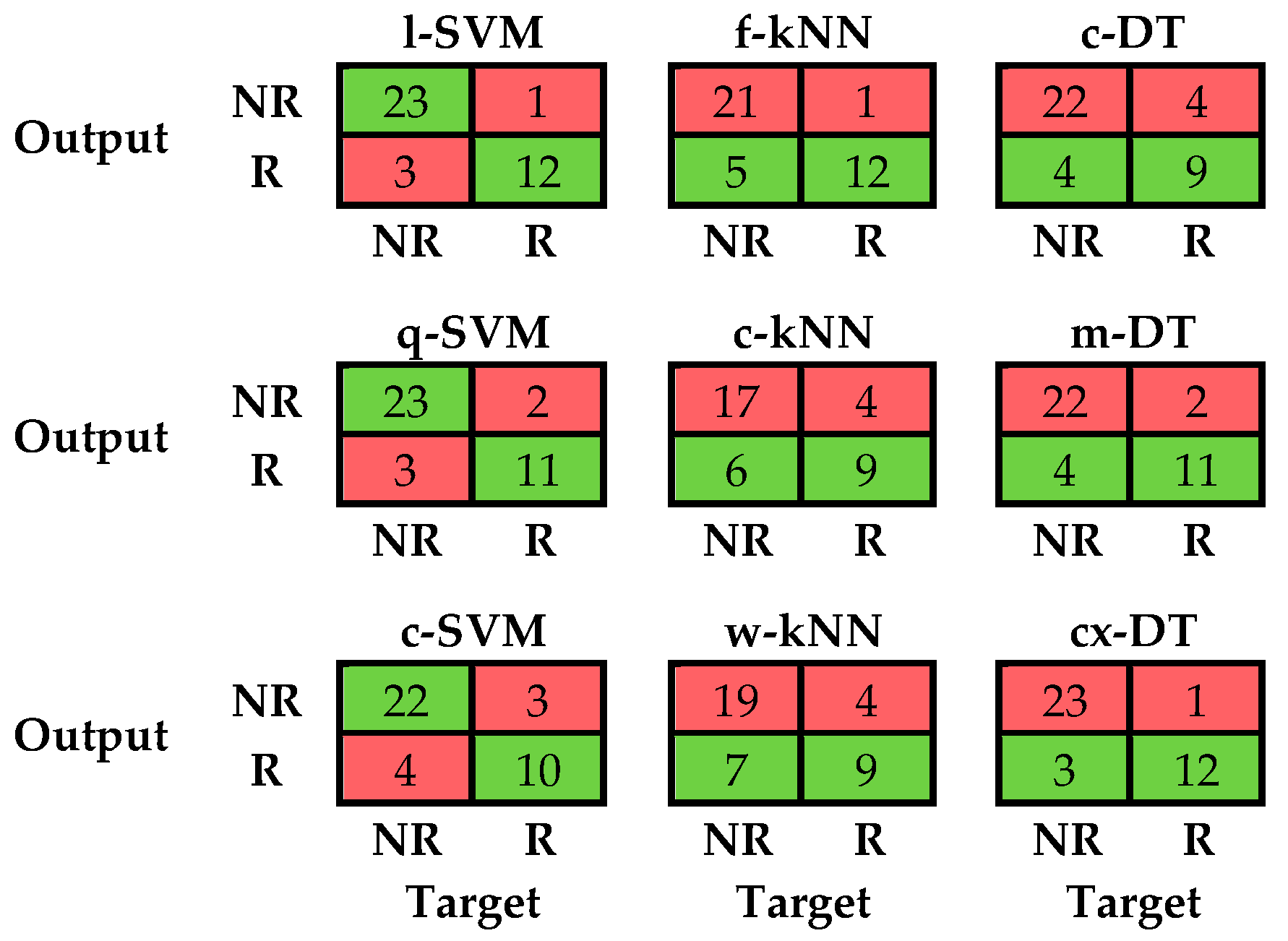
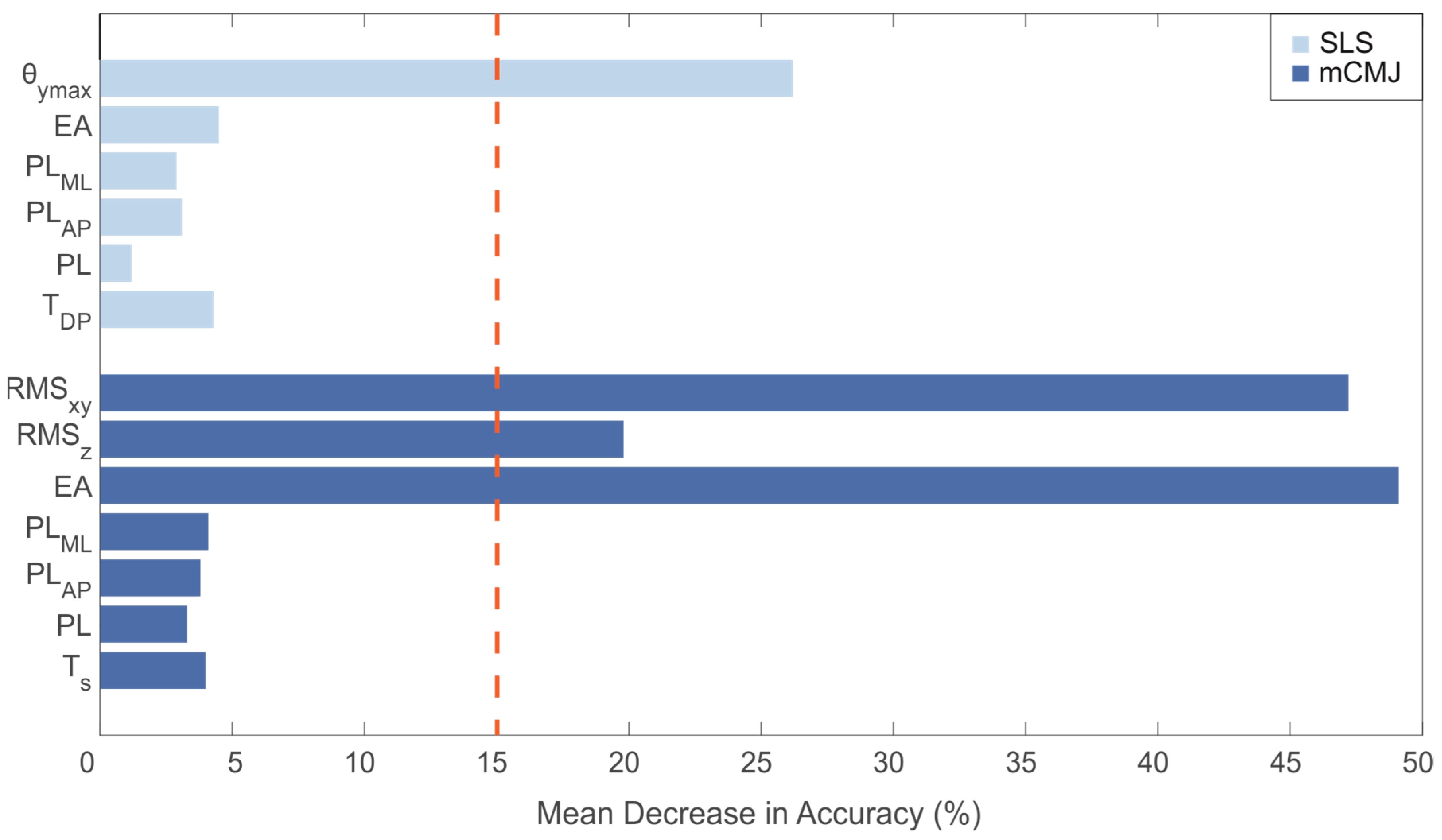
| Item | Possible Score |
|---|---|
| 0 = yes 1 = no |
| 0 = yes 1 = no |
| 0 = trunk is flexed 1 = not flexed |
| 0 = trunk is vertical 1 = not vertical |
| 0 = toe to heel 1 = no |
| 0 = no 1 = yes |
| 0 = no 1 = yes |
| 0 = no 1 = yes |
| 0 = no 1 = yes |
| 0 = yes 1 = no |
| 0 = yes 1 = no |
| 0 = no 1 = yes |
| 0 = yes 1 = no |
| 0 = yes 1 = no |
| 0 = yes 1 = no |
| 0 = soft 1 = average 2 = stiff |
| 0 = excellent 1 = average 2 = poor |
| Features | mCMJ | SLS | |
|---|---|---|---|
| Leg stability | PL (cm) | ✓ | ✓ |
| PLAP (cm) | ✓ | ✓ | |
| PLML (cm) | ✓ | ✓ | |
| EA (cm2) | ✓ | ✓ | |
| Load absorption | RMSz (m/s2) | ✓ | |
| RMSxy (m/s2) | ✓ | ||
| Leg mobility | θymax (°) | ✓ | |
| Time parameters | Ts (s) | ✓ | |
| TDP (s) | ✓ | ||
| Geometric | Binary | |
|---|---|---|
| SVM | kNN | DT |
| Linear (l-SVM) | Fine (f-kNN) | Coarse(c-DT) |
| Quadratic (q-SVM) | Cosine (c-kNN) | Medium (m-DT) |
| Cubic (c-SVM) | Weighted (w-kNN) | Complex (cx-DT) |
| Task | Features | R | NR |
|---|---|---|---|
| mCMJ | TS (s) | 0.21 (0.04) | 0.33 (0.06) |
| PL (cm) | 2.7 (0.9) | 2.9 (0.8) | |
| PLAP (cm) | 1.5 (0.5) | 1.6 (0.3) | |
| PLML (cm) | 2.8 (0.2) | 1.1 (0.1) | |
| EA (cm2) | 1.5 (0.2) | 0.7 (0.2) | |
| RMSz (m/s2) | 247.4 (85.6) | 95.6 (19.4) | |
| RMSxy (m/s2) | 169.4 (26.7) | 70.1 (14.9) | |
| SLS | TDP (s) | 3.22 (0.95) | 3.90 (1.23) |
| PL (cm) | 0.8 (0.1) | 0.8 (0.3) | |
| PLAP (cm) | 0.6 (0.1) | 0.6 (0.2) | |
| PLML (cm) | 0.4 (0.1) | 0.5 (0.2) | |
| EA (cm2) | 0.5 (0.0) | 0.7 (0.0) | |
| θymax (°) | 16.8 (2.7) | 26.0 (5.3) |
| A | F1-Score | G | |
|---|---|---|---|
| l-SVM | 0.95 | 0.96 | 0.08 |
| q-SVM | 0.87 | 0.87 | 0.19 |
| c-SVM | 0.82 | 0.81 | 0.28 |
| f-kNN | 0.85 | 0.86 | 0.21 |
| c-kNN | 0.67 | 0.71 | 0.46 |
| w-kNN | 0.74 | 0.75 | 0.35 |
| c-DT | 0.79 | 0.79 | 0.34 |
| m-DT | 0.85 | 0.85 | 0.22 |
| cx-DT | 0.90 | 0.90 | 0.14 |
| r | p-Value | |
|---|---|---|
| EA | 0.88 | 0.01 |
| RMSz | 0.25 | 0.12 |
| RMSxy | 0.59 | 0.04 |
| θymax | 0.60 | 0.03 |
Publisher’s Note: MDPI stays neutral with regard to jurisdictional claims in published maps and institutional affiliations. |
© 2021 by the authors. Licensee MDPI, Basel, Switzerland. This article is an open access article distributed under the terms and conditions of the Creative Commons Attribution (CC BY) license (https://creativecommons.org/licenses/by/4.0/).
Share and Cite
Taborri, J.; Molinaro, L.; Santospagnuolo, A.; Vetrano, M.; Vulpiani, M.C.; Rossi, S. A Machine-Learning Approach to Measure the Anterior Cruciate Ligament Injury Risk in Female Basketball Players. Sensors 2021, 21, 3141. https://doi.org/10.3390/s21093141
Taborri J, Molinaro L, Santospagnuolo A, Vetrano M, Vulpiani MC, Rossi S. A Machine-Learning Approach to Measure the Anterior Cruciate Ligament Injury Risk in Female Basketball Players. Sensors. 2021; 21(9):3141. https://doi.org/10.3390/s21093141
Chicago/Turabian StyleTaborri, Juri, Luca Molinaro, Adriano Santospagnuolo, Mario Vetrano, Maria Chiara Vulpiani, and Stefano Rossi. 2021. "A Machine-Learning Approach to Measure the Anterior Cruciate Ligament Injury Risk in Female Basketball Players" Sensors 21, no. 9: 3141. https://doi.org/10.3390/s21093141
APA StyleTaborri, J., Molinaro, L., Santospagnuolo, A., Vetrano, M., Vulpiani, M. C., & Rossi, S. (2021). A Machine-Learning Approach to Measure the Anterior Cruciate Ligament Injury Risk in Female Basketball Players. Sensors, 21(9), 3141. https://doi.org/10.3390/s21093141









